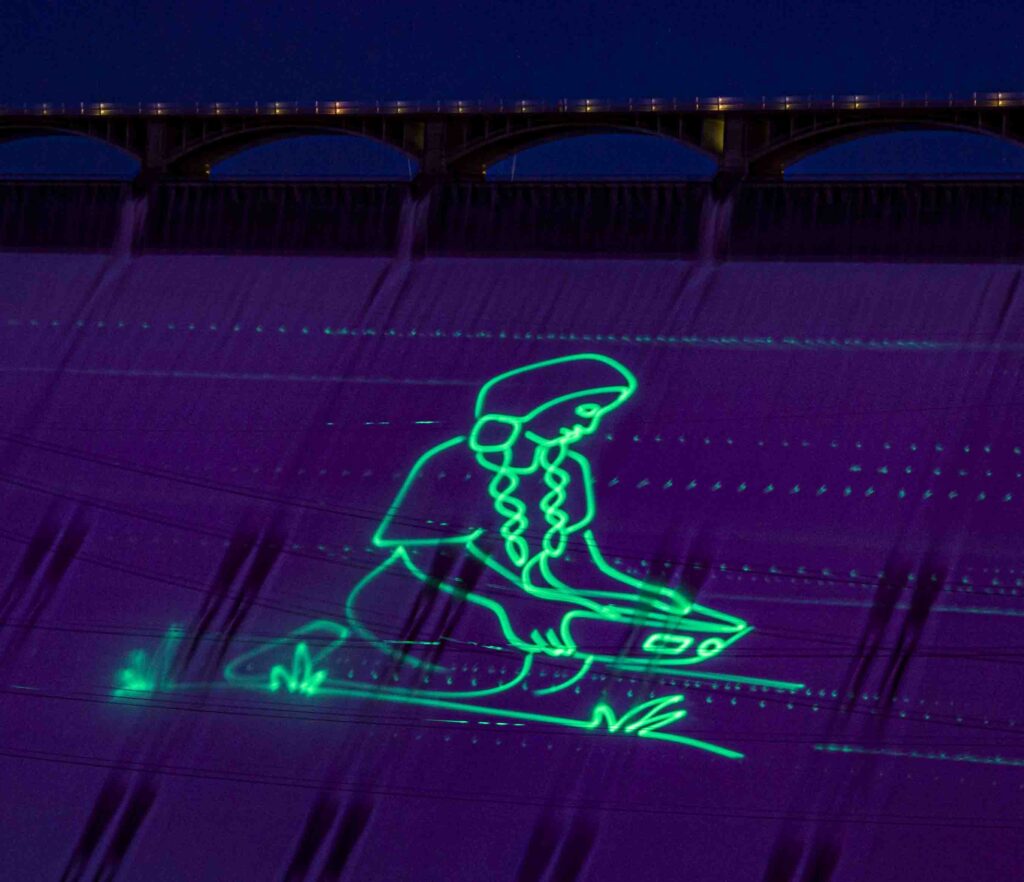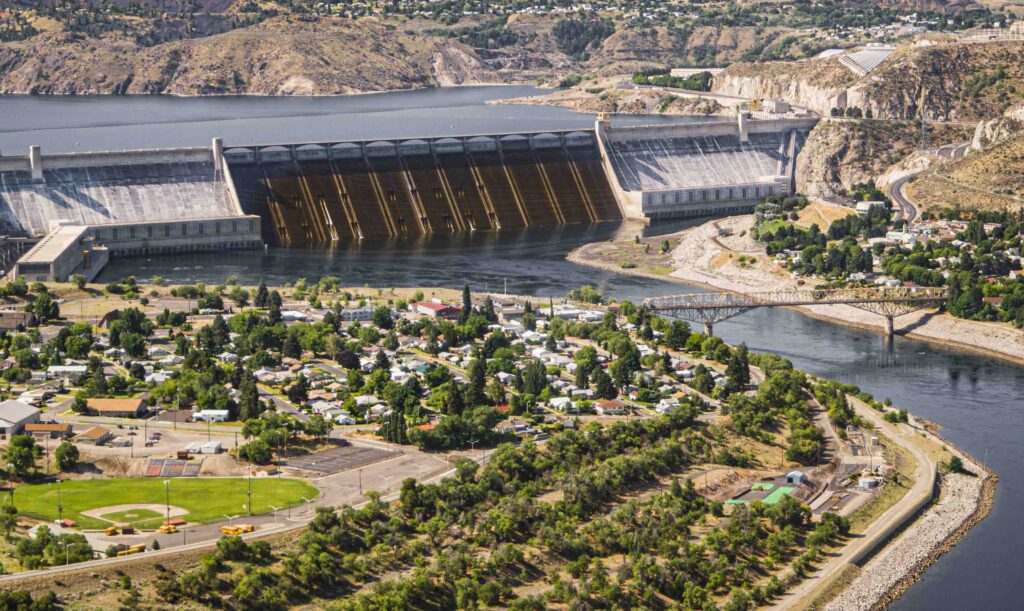“One River, Many Voices”
Columbia River Basin
|
NEW ESRI StoryMaps: What's On Our Shelves & NWNL Song Library & No Water No Life ESRI |
Columbia River Basin
Arriving in Grand Coulee in the dark of night in the dark to for the Grand Coulee Dam Sound & Laser Light Show leaves a visitor informed and indelibly impressed! The US Bureau of Reclamation’s riveting, half-hour summer presentation, full of history and awe, is focused on a 550-foot wall of concrete. One of the largest dams in the world, Grand Coulee forms Lake Roosevelt as it holds back the Columbia River, considered by many to be the life source of the Pacific Northwest. The transcription is from the audio representing “the voice” of the Columbia River.
(NB Due to the background roar of the Grand Coulee Dam some words on the transcription of this tape were missing. NWNL filled in words to made sense of dropped phrases or sentences.)
All images © Alison M Jones. All rights reserved.

Out of chaos, I was born. Throughout time I have raged. I am power. I am streams. I am “The River Columbia.” I am life. I have fed the life’s blood of many creatures and fed their pups through time. They have drunk of my bounty and prospered at my side. Many different tribes are here using variations of only four spoken tongues. They were the ancestors. These were the first. All had a different name for me and showed the greatest respect.
I was named after the sturdy ship. That name, Columbia, has been with me from that day. Nearly a decade would pass. Then a daring team of explorers blazing their way across the nation encountered my waters. These two men were searching for a route across America. I, over the course of eons, have carved through the bedrock of the country. It was inevitable that our paths would cross. Upon their return east, Lewis and Clark told their story to countrymen who listened with excitement as they heard of the vast fertile lands to the west – and the mighty Columbia River.
As settlers flocked west to the promise of power in my homelands, they found excellent topsoil. Farming began, and the crops were fruitful and productive for a time. A number of years of above average rainfall meant that crops were doomed to failure. It became pitifully apparent that, unless a means could be found to halt the erosion of the topsoil, this whole expanse of fertile lands soon could be turned into desert. The hundreds of thousands of acres cleared for farmland began to blow away.
A small group of dedicated people devised a plan to construct a dam. Despite understanding and sharing in sorrow and concern felt by Native Americans, they sought to distribute my life-giving waters in hopes of green acres in a thirsty land. Their vision eventually led to a full-scale government study of the Columbia Basin. This report not only favored the dam, but went further, condemning my swirling waters. The largest dam of them all was a tool of absolute control of my entire path: the Grand Coulee Dam. To the President of the United States, Franklin D. Roosevelt, this project involved a costly expenditure, but also a valuable new building block for the nation – an investment that would not only give back many times over; but would strengthen this country by strengthening its resources.
In the time following the Great Depression, allocating such massive funding was a bold move, but a convinced FDR made the project part of his Public Works Administration project, supplying jobs to the nation’s unemployed and helping to put a nation back to work. When the ground was broken on July 16, 1933, it caused jobs to start to a flow of workers, transforming a population of less than 25 to more than 16,000 with over 11,000 men and women working on the dam.
In my thousands of centuries of existence, never have I witnessed a more ambitious task. Twenty-two million cubic yards of dirt and rock had to be removed. Miles of holes were drilled into the bedrock to test for fissures. Tons of concrete were pumped into fissures, readying the bedrock for twelve million cubic yards of concrete. A refrigeration plant had to be installed to freeze areas of potential landslides.

My natural course had to be diverted. One block at a time, concrete was poured, and the dam began to grow. Soon my waters were backing up behind the dam. As a new lake began to form, surveyors marked out a line 1,290 feet above sea level. Everything below would be submerged in my icy depths. Now arising, in stark contrast to the grand scope and vision of the project’s benefits, came the hard realities of the tradeoffs for such aspiring dreams. Eleven towns were abandoned. A once thriving salmon run was reduced and many native American tribal fishing sites disappeared. American Indians gathered for a Ceremony of Tears when their tribal fishing grounds of Kettle Falls was overrun.
Measures were taken to make up for the loss. Salmon runs were transplanted to downriver tributaries. Fish ladders and lifts were installed where possible, and hatcheries were created to stock the newly formed lakes. The message was clear. No change in the land could be without a change in the lives of those who inhabited the land. To both man and animal, painful were these tradeoffs; but the benefits of this single project soon would serve the entire country.
Many years after it was begun, this largest concrete structure in the world backed up an impoundment [Lake Roosevelt] longer than nearly 150 miles all the way to the Canadian border. The Grand Coulee Dam had been completed. Very soon afterwards, Chief Jim James of the Sanpoil Band of the Colville Nation, punched a button, delivering the first hydro-electric energy from the dam to the Coleville Confederated Tribes Reservation I was now the driving force behind the largest hydro-electric dam in the world. Hydroelectricity created an inexpensive production of electric power from water. It may sound like a difficult task for a river, but I understand its potential. Allow me to explain.
The process begins with water and the certainty that it will always flow downhill. The great force of water rushing into this confined space pushes against the blades, which in turn rotate a shaft and a powerful electric magnet called a rotor. These rapidly moving rotors cause electrons to create electricity. The water is then discharged where it continues along its graceful path to the ocean.
With the Allied victory, the time now arose to focus on the original dream, the delivery of a steady supply of life-giving waters to over one million acres of parched and arid land. Construction began on a pumping plant to lift these waters 280 feet up and over the canyon wall. This water would fill a tremendous reservoir now known as Banks Lake, and from there feed thousands of miles of canals and drains which would ultimately feed the land.
As the population of the Pacific Northwest has grown, the Grand Coulee Dam has expanded to serve. Extensions of major canals and lateral systems irrigate more lands. Pump generators were installed to take advantage of low-demand periods. Extra water is pumped up to be used later and generate electricity during peak demands. And the demolition of part of the east part of the dam made way for the new third power plant, literally tripling the power output of Grand Coulee.
I was once a raging torrent of raw energy and thundering rapids, crashing headlong to the ocean. I represented potential energy spent carving the land on my race to the sea. Now my power is harnessed and I am part of an efficient system that serves the people and the land. At Grand Coulee Dam alone, my waters can generate a staggering 6,500,000 kilowatts. This electricity not only provides a large share of the power needs for the entire Pacific Northwest, but it generates revenue to pay for the dam and to fund the irrigation development in the region.
In addition to harnessing my power, mankind has bridled my terrible capacity for destruction. Before, I controlled the forces of nature that could lead to a devastating flood. Now the Grand Coulee Dam, with the enormous capacity of Lake Roosevelt, has sufficient space to help control these wild flows.
Posted by NWNL on November 15, 2023.
Transcription edited and condensed for clarity by Alison M. Jones.
All images © Alison M. Jones, unless otherwise noted. All rights reserved.
